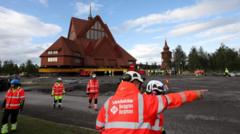The clock struck early in Kiruna as a monumental event began: the relocation of a 113-year-old church, threatened by ground subsidence, began its two-day journey across the Swedish city. The vast, red timber church, originally constructed in 1912, is being transferred 5 kilometers (3 miles) to the new city center with the operation set to travel at a pace of 500 meters an hour.
This relocation is crucial due to the dangers posed by the extensive iron ore mining operations in the area, which have resulted in ground fissures endangering both infrastructure and the community. Culture strategist Sofia Lagerlöf Määttä expressed relief, stating, "It's like finally, let's get it done. We've been waiting for so many years."
Project manager Stefan Holmblad Johansson emphasized the meticulous preparations undertaken for this historic operation. "Everything is under control," he stated, displaying confidence built on years of planning. Since the mid-2010s, Kiruna has been strategically shifting buildings to mitigate risks associated with mining; some have been demolished while others have been relocated intact.
Under Swedish law, mining cannot occur beneath buildings, as it poses a significant threat to essential services such as water and electricity. Robert Ylitalo, CEO of Kiruna's development company, assured that infrastructure integrity was a priority, highlighting the need for the community to move proactively to avoid crises.
The church, measuring 35 meters (115 feet) high, 40 meters wide, and weighing an impressive 672 tonnes, stands as a vital spiritual and historical landmark, having previously been named Sweden's most beautiful pre-1950 building. The engineering feat of moving such a sizable structure intact involves supporting it with steel beams and using self-propelled modular transporters.
Crucial to the operation was preparing the route for the wide church structure; modifications included expanding road widths and removing obstacles along the journey, including traffic signals and old bridges. Notably, among the interior treasures, the church's altar painting, created by Prince Eugen, and its grand pipe organ have been carefully secured to remain during the move.
For residents and the community, this relocation is steeped in emotion and nostalgia. Määttä reminisced about her childhood memories in the church, while Johansson, a member of the church’s gospel choir, highlighted the personal significance of the move.
Vicar Lena Tjärnberg articulated the bittersweet sentiment surrounding the change, acknowledging the church's roots in its original location. While recognizing the need for relocation due to the mining community's realities, she expressed sadness about leaving the cherished ground.
As the relocation progresses, residents, including King Carl Gustaf of Sweden, are poised to witness this unique historical event, with Swedish television scheduled to broadcast the journey live, marking a collective memory that transcends time and change.
This relocation is crucial due to the dangers posed by the extensive iron ore mining operations in the area, which have resulted in ground fissures endangering both infrastructure and the community. Culture strategist Sofia Lagerlöf Määttä expressed relief, stating, "It's like finally, let's get it done. We've been waiting for so many years."
Project manager Stefan Holmblad Johansson emphasized the meticulous preparations undertaken for this historic operation. "Everything is under control," he stated, displaying confidence built on years of planning. Since the mid-2010s, Kiruna has been strategically shifting buildings to mitigate risks associated with mining; some have been demolished while others have been relocated intact.
Under Swedish law, mining cannot occur beneath buildings, as it poses a significant threat to essential services such as water and electricity. Robert Ylitalo, CEO of Kiruna's development company, assured that infrastructure integrity was a priority, highlighting the need for the community to move proactively to avoid crises.
The church, measuring 35 meters (115 feet) high, 40 meters wide, and weighing an impressive 672 tonnes, stands as a vital spiritual and historical landmark, having previously been named Sweden's most beautiful pre-1950 building. The engineering feat of moving such a sizable structure intact involves supporting it with steel beams and using self-propelled modular transporters.
Crucial to the operation was preparing the route for the wide church structure; modifications included expanding road widths and removing obstacles along the journey, including traffic signals and old bridges. Notably, among the interior treasures, the church's altar painting, created by Prince Eugen, and its grand pipe organ have been carefully secured to remain during the move.
For residents and the community, this relocation is steeped in emotion and nostalgia. Määttä reminisced about her childhood memories in the church, while Johansson, a member of the church’s gospel choir, highlighted the personal significance of the move.
Vicar Lena Tjärnberg articulated the bittersweet sentiment surrounding the change, acknowledging the church's roots in its original location. While recognizing the need for relocation due to the mining community's realities, she expressed sadness about leaving the cherished ground.
As the relocation progresses, residents, including King Carl Gustaf of Sweden, are poised to witness this unique historical event, with Swedish television scheduled to broadcast the journey live, marking a collective memory that transcends time and change.






















